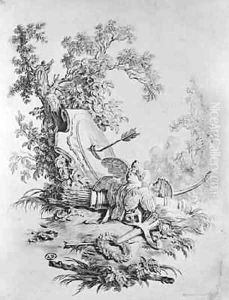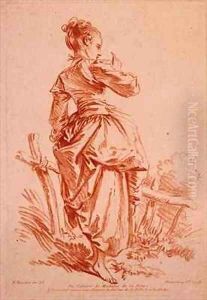Giles Demarteau Paintings
Giles Demarteau, also known as Gilles Demarteau l'ainé, was a distinguished French engraver and printmaker born in 1722 in Liège, which was then part of the Prince-Bishopric of Liège and now is in Belgium. Demarteau is particularly renowned for his mastery in the technique called crayon manner engraving, a method that emulates the soft and textured quality of chalk drawings. This technique was pivotal in the 18th century for its ability to replicate the delicate nuances of pastel and chalk artworks, making it possible for these works to be enjoyed in print form by a wider audience.
Demarteau moved to Paris, the heart of the artistic and cultural movement in France, where he established his career and reputation. His studio became a hub for the production of crayon manner engravings. He obtained a royal privilege for his engraving technique in 1757, which was a testament to his innovation and the high esteem in which he was held. This privilege allowed him exclusive rights to produce and sell his crayon manner prints, a significant achievement that underscored his unique position in the art world of his time.
Throughout his career, Demarteau collaborated with and reproduced works of leading artists of his day, such as François Boucher, Jean-Honoré Fragonard, and Jean-Baptiste Greuze, thus playing a crucial role in disseminating contemporary French art. His works were not just mere copies but were regarded as reinterpretations that added a new layer of aesthetic appreciation to the originals. Demarteau's engravings were sought after by collectors and art enthusiasts across Europe, contributing to the spread of French tastes and styles.
Demarteau's contribution to the art of engraving and the promotion of French art during the 18th century was significant. His ability to capture the essence and beauty of chalk and pastel artworks through the medium of print was unparalleled. He died in Paris in 1776, leaving behind a legacy that had a lasting impact on the printmaking world. His works continue to be appreciated for their beauty and technical prowess, and they remain a testament to the vibrant artistic culture of the 18th-century French Rococo period.

